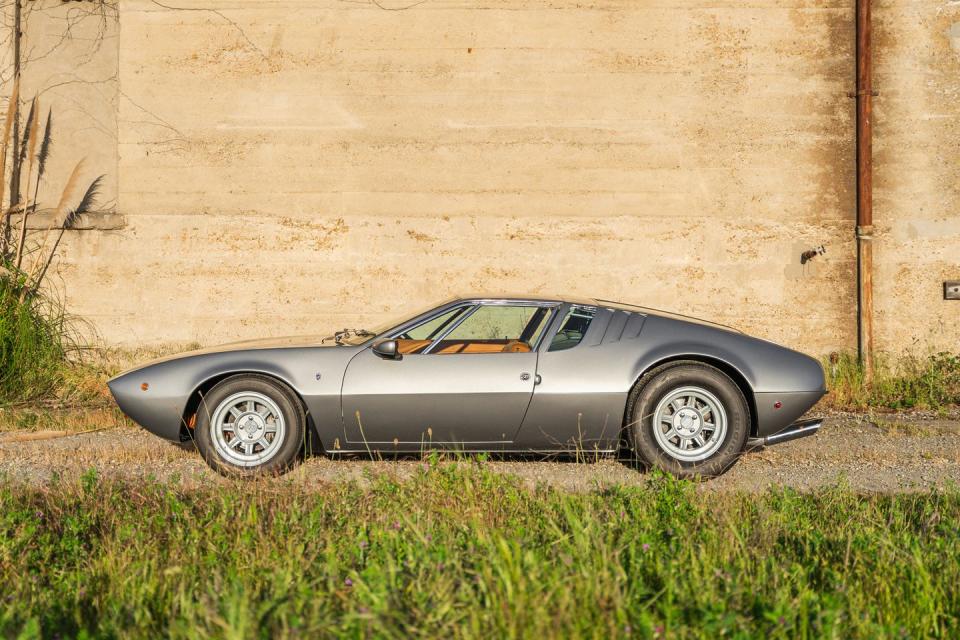1969 De Tomaso Mangusta Is Today's Bring a Trailer Pick

Alejandro de Tomaso's second production car, the Mangusta, was born from a failed racing partnership with Carroll Shelby. Italian for "mongoose," the name was a deliberate jab at Shelby's Cobra, and the car reused bits of the stillborn racer.
While a racing-derived chassis and a burbling Ford V-8 meant fun, it was Giorgetto Giugiaro’s sinuous, stunning styling that made the Mangusta a legend.
It was notoriously cramped and tricky to drive, so many of the 401 Mangustas built have been modified to make them more usable. This one got a major refurbishment in 2012.
Alejandro de Tomaso was nothing if not full of drama, but the De Tomaso Mangusta is the most over-the-top car the mercurial Argentinian ever created. Born from a dust-up with Carroll Shelby, it even had a name designed to attract attention. Mongooses, according to Rudyard Kipling, famously hunt Cobras. The mid-engine Mangusta with its Ford V-8 was a raw, raucous race car for the road, but its shape was even more dramatic than its mechanicals. Thanks to Giorgetto Giugiaro's gorgeous lines, it still looks like a predator poised to pounce.

The Mangusta didn't end up killing the Cobra and often drew criticism for being better to look at than drive, but it did put De Tomaso on the global map. Ford took notice and teamed up with the firm for the more familiar (and refined) Pantera in 1971. Before that, 401 Mangustas were made, including this 1969 example for sale on Bring a Trailer (which, like Car and Driver, is part of Hearst Autos).

Amazingly, the Mangusta was only De Tomaso's second road car, and the first built in quantity. Both accomplished racers, de Tomaso and his American wife, Isabelle Haskell, founded De Tomaso Automobili in 1959 to make competition cars. To woo investors and partners, they launched a road car, the Ford Cortina–powered Vallelunga, in 1963. It worked.
Among the many projects De Tomaso was working on by 1964 was the P70 racer. Designed for Shelby with help from designer Pete Brock and meant for the U.S. Road Racing Championship, it would use the Vallelunga's backbone chassis and a 427-cubic-inch version of Ford's 289-cubic-inch V-8. De Tomaso wasn't able to stretch Ford's small-block that far and couldn't build the car in time for the 1965 racing season, so a frustrated Shelby pulled out.

While Shelby moved on to the GT40, struggling De Tomaso salvaged the P70 ideas for another road car. Mechanically, the Mangusta used the P70's backbone chassis, a Shelby-tuned 289 V-8, and a rear-mounted ZF five-speed gearbox. For a body, De Tomaso turned to Ghia and a recently hired superstar, Giorgetto Giugiaro.
Having just left Bertone, Giugiaro was keen to explore new styles, and that's just what he did. Though Bertone's Lamborghini Miura stole the Geneva show in March of 1966, the futuristic Mangusta wowed at Turin that October. Its low-slung profile, ultra-clean details, and dramatic gullwing-hinged hood panels later had Car and Driver labeling it "the most beautiful car in the world."
Though he and Shelby remained friends, the Mangusta name was typical of de Tomaso's attention-seeking antics. Suggesting rivalry generated PR, which his company desperately needed.

To make money, of course, the car had to get built and sold in America. Here, Haskell's connections and political acumen came into play. Through relatives, she and de Tomaso secured the funding to buy Ghia and build bodies. Though emissions rules required fitting a 230-hp 302-cubic-inch V-8 to U.S. cars, somehow they also got the Mangusta exempted from safety regulations until 1970. The cars didn't even have seat belts.
Mangustas began arriving in 1968 and they made a big impression. It looked amazing and though costly at $11,150, it was much cheaper than a Ferrari. It was quick, too; but fragile, cramped, and a handful to drive.
Early supercars were rarely designed for ergonomics, but Mangustas were confining even by 1960s standards, with a terrible driving position and non-adjustable, uncomfortable seats. With most of the weight in the back, it took much fettling with the suspension and better-than-stock tires to get the car to handle well. The heavy clutch, hard ride, and poor shift linkage rankled, and the chassis was a bit too flexible for the V-8's power. But oh, those looks!
It was also made by hand, sometimes crudely. Ford design VP Eugene Bordinat's purchase of a Mangusta sparked Dearborn's interest, but De Tomaso's quality appalled Ford execs, who insisted on much stricter standards for the Pantera.
The Mangusta's rarity, style, and reputation for unforgiving handling eventually gave it a mythical quality. It's still gorgeous, intimidating, and fast, but most of the Mangusta's deficiencies have been tamed with time, aftermarket parts, and modern tires. This 24,000-mile car got a major renovation in 2012, including a repaint into silver and a tan leather interior (it was originally red over black). It's done about 4000 miles since and looks ready for action.
It won't come cheap, but every drive in this would be an adventure and it'll captivate everyone who sees it. If you want this four-wheeled snake charmer, the auction ends May 24.
You Might Also Like

 Yahoo Autos
Yahoo Autos 